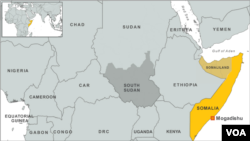After a poor rainy season early this year, parts of southern Somalia now are being hit with severe floods. The rainy season that began in October has caused flooding along the Shebelle and Juba Rivers. The U.N. Food and Agriculture Organization warns that’s making ongoing food insecurity even worse.
The U.N. estimates more than one-million people in Somalia are in urgent need of assistance – a 20-perent increase in the past six months. What’s more, it says another two-million people are facing threats to their food security.
Much of Somalia’s farming takes place along the Shabelle and Juba Rivers. Along the Shabelle, the town of Belet Weyne is the worst hit. Along the Juba, flooding is reported in Dollow, Jilib and Jamame.
The FAO’s Acting Head of Office for Somalia Luca Alinovi said the embankments have not been maintained – making it much easier for the rivers to overflow and inundate agricultural land.
“So that has implications directly for the people in the town. But also it has a lot of implications for both the people in the rural area and their capacity of producing crops, but also sustaining animals,” he said.
The Gu rainy season runs from April to June in Somalia. But this year, it was a poor one, causing agricultural production to drop 35-percent below the average.
Memories of the 2011 famine are still fresh. Hundreds of thousands of people died. Humanitarian officials are worried it could happen again. Alinovi said food security indicators are warning of problems ahead.
“What happened in 2011, which eventually led to the famine situation, was that we had those bad indicators – and had a very poorly funded humanitarian appeal, which is exactly what is happening today.”
Alinovi said only 34-percent of the 2014 humanitarian appeal for Somalia has been received.
“If we don’t support the people who produce the food where they are, what is happening is that they move out and they become displaced and refugees as it happened several times during crises. We don’t want this happening again. And more over, we have a double effect because the people displaced become people in need of support,” he said.
The current rainy season – the Dayr – is the shortest and usually ends in December. But it’s just begun. So it’s not known when heavy rains will subside and allow the flood waters to recede.
The Food and Agriculture Organization said the Somalis in rural areas are still not resilient enough to withstand constant shocks to the food system. Alinovi said that takes years to accomplish.
“If we don’t continue to provide consistent support to the farmers where they are – to the pastoralists where they are – to the fisherman where they are – helping them to manage this variability of risk which happens every few minutes – we will end up to have people with their capacity more and more eroded.”
The FAO said the combination of poor rains and floods have hurt both cereal and livestock production. At the same time, conflict involving the al-Shabab militant group has disrupted trade routes. As a result food prices have soared in some areas.
The U.N. agency estimated with current donor funds it can assist about 210,000 people through December. It said an additional $49-million dollars is needed to extend assistance to another 140,000 people through the first half of 2015.










